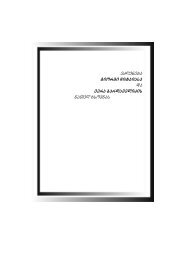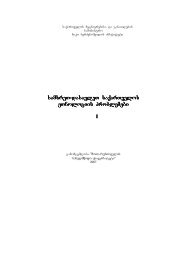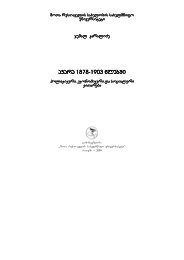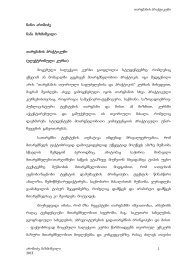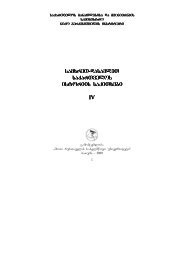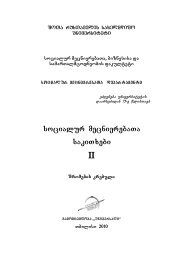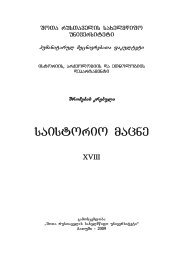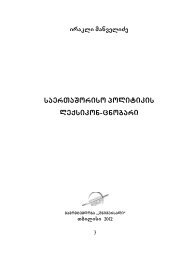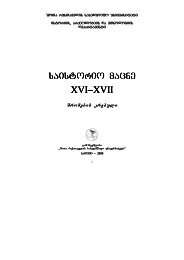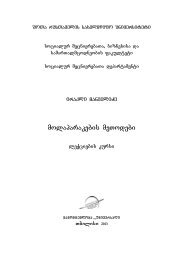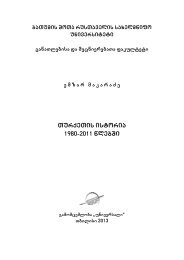Cveni sulierebis balavari II
Cveni sulierebis balavari II
Cveni sulierebis balavari II
- No tags were found...
You also want an ePaper? Increase the reach of your titles
YUMPU automatically turns print PDFs into web optimized ePapers that Google loves.
The church of Golden-Saint Father (Okros Mamawminda), beforearcheological researches was saved by the rudiments of well-chosen torn tones andrudiments of walls built by local stones. In spite of it, because of archeologicalsurface reconnaissance found architectural details made possible to work out generalpicture of the possible preliminary architectural layout. For example, the churchmust be a right-angled plan. Besides, there mentioned two naked constructions likecolumns in the interior, which did not exclude its basilica type belonging.Approximately, outside overall dimensions were as follows: east and west walls –5,6 m, north and south 7,5 m long. Order of south and north walls was averagely 2 mhigh was maintained, but west and east walls were destroyed fundamentally. Afterlong time of liturgy secession in the church, local community immediately rebuiltthe walls with local dry stones order until some height. Inside space, on south wallof the church, on the top of old head lately built with dry order, small sized likelumber chink the chapel of alcove. The south wall, where the door’s chink arranged,bordered with rock steepness. Currently is unknown how the parish entered in theoriginal church.It is the first case to discover basilica planned little chapel in the highmountain region in Georgia. It is true, the church of Golden-Saint Father (OkrosMamawminda) alter as off mono-basilica churches has a right-angled plan, but quitehigh artificial plastic decision and decorative facade stones reveal the especiallylayout basilica may played the special missionary role in the glorious conclusion andestablishment of Christianity in V<strong>II</strong>I-IX centuries. Because there no any populatedare there in 5-6 km distance and one can found little living building traces, we do notexclude the monastery led as an extremely ascetically organized life.Based on artificial methods the church dated back by us and its functioningphases proved by cultural layers of archeological excavations in the building interior– actually there was found some ceramic fragments which are well-known fromarcheological monuments in east Georgia and near abroad countries in V<strong>II</strong>I-IXcenturies.In the late middle ages, after Tamerlane invasion (on the eve of XIV-XVcenturies), Georgia was in political and economical crises; regular liturgy wasaccordingly deranged in the church of Golden-Saint Father (Okros Mamawminda).Periodically prayers call off the church and because of neglect the church destroyedstep-by-step. Some trying to restore it with dry order stones was not effective andfinally approximately XVI-XX centuries the place was only the memory of old gloryand changed in place of semi-pagan celebrations.The church of Golden-Saint Father (Okros Mamawminda) needs the specialresearch for the future to compare architecture and décor of the Christian churches inthe Caucasia. Archeological excavations proved, Khevi before built of GergetiTrinity, was the centre of extremely important spread of Transcaucasia Christianity.Members of Stapantsminda and Khevi eparchy currently make everything torestore the church of Golden-Saint Father (Okros Mamawminda) and liturgyrenewal.67



